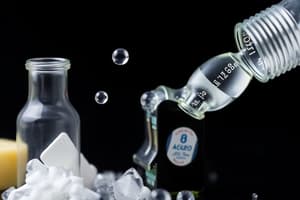Podcast
Questions and Answers
Which characteristic is NOT essential for a preservative to function effectively?
Which characteristic is NOT essential for a preservative to function effectively?
- High toxicity (correct)
- Stability to heat and storage
- Acceptable taste, odor, and color
- Effective against microbial growth
Which of the following antimicrobial agents is primarily an antifungal?
Which of the following antimicrobial agents is primarily an antifungal?
- Benzoic acid (correct)
- Phenol
- Formaldehyde
- Chlorhexidine
What property must a preservative exhibit to penetrate bacteria effectively?
What property must a preservative exhibit to penetrate bacteria effectively?
- Unionized state (correct)
- High molecular weight
- High cost
- Insolubility in water
Which of the following is a quaternary ammonium compound used as an antimicrobial agent?
Which of the following is a quaternary ammonium compound used as an antimicrobial agent?
Why should a preservative not bind to other components of an emulsion?
Why should a preservative not bind to other components of an emulsion?
Which of the following methods can prevent autoxidation?
Which of the following methods can prevent autoxidation?
Which of the following is a suitable example of an antioxidant for oral use products?
Which of the following is a suitable example of an antioxidant for oral use products?
What type of physical instability involves the merging of droplets in an emulsion?
What type of physical instability involves the merging of droplets in an emulsion?
Which of the following options is NOT a type of physical instability of emulsions?
Which of the following options is NOT a type of physical instability of emulsions?
Which antioxidant is known for its bitter taste and is used in pharmaceuticals and cosmetics?
Which antioxidant is known for its bitter taste and is used in pharmaceuticals and cosmetics?
What is the primary cause of creaming in an emulsion?
What is the primary cause of creaming in an emulsion?
What does the phenomenon of creaming visually manifest as?
What does the phenomenon of creaming visually manifest as?
How is creaming classified in terms of reversibility?
How is creaming classified in terms of reversibility?
What size of droplets may settle preferentially during creaming?
What size of droplets may settle preferentially during creaming?
What is the main characteristic of the protective sheath surrounding oil globules during creaming?
What is the main characteristic of the protective sheath surrounding oil globules during creaming?
What determines the reversibility of flocculation?
What determines the reversibility of flocculation?
Which factor contributes to the extent of flocculation of globules?
Which factor contributes to the extent of flocculation of globules?
What is a consequence of having uniform sized globules in an emulsion?
What is a consequence of having uniform sized globules in an emulsion?
How can charge on the globule surface be increased?
How can charge on the globule surface be increased?
What effect does increasing the viscosity of the external medium have on flocculation?
What effect does increasing the viscosity of the external medium have on flocculation?
What is a characteristic of cationic surfactants?
What is a characteristic of cationic surfactants?
Which of the following is classified as an anionic surfactant?
Which of the following is classified as an anionic surfactant?
Which natural hydrocolloid can be derived from plant sources?
Which natural hydrocolloid can be derived from plant sources?
What role do semi-synthetic surfactants play in emulsions?
What role do semi-synthetic surfactants play in emulsions?
Which of the following encompasses both animal and plant-derived emulsifying agents?
Which of the following encompasses both animal and plant-derived emulsifying agents?
What is the definition of an emulsion?
What is the definition of an emulsion?
What is the role of the emulsifying agent in an emulsion?
What is the role of the emulsifying agent in an emulsion?
In an emulsion, what is referred to as the internal phase?
In an emulsion, what is referred to as the internal phase?
Which phase is known as the external phase in an emulsion?
Which phase is known as the external phase in an emulsion?
What distinguishes an emulsion from a suspension?
What distinguishes an emulsion from a suspension?
What are emulsifying agents primarily used for in an emulsion?
What are emulsifying agents primarily used for in an emulsion?
Which process is NOT involved in how emulsifying agents stabilize emulsions?
Which process is NOT involved in how emulsifying agents stabilize emulsions?
Which of the following is a pharmaceutical requirement for emulsifying agents?
Which of the following is a pharmaceutical requirement for emulsifying agents?
What is one of the mechanisms through which an emulsifying agent provides stability to an emulsion?
What is one of the mechanisms through which an emulsifying agent provides stability to an emulsion?
Which type of additive is specifically categorized as an emulsifying agent?
Which type of additive is specifically categorized as an emulsifying agent?
Which of the following is a component of colloidal clays?
Which of the following is a component of colloidal clays?
What is the primary use of methyl cellulose in emulsions?
What is the primary use of methyl cellulose in emulsions?
Which product is considered a lipophilic thickening agent for lotions?
Which product is considered a lipophilic thickening agent for lotions?
Which of the following is classified as a metallic hydroxide?
Which of the following is classified as a metallic hydroxide?
What happens to stearic acid when it is reacted with alkali?
What happens to stearic acid when it is reacted with alkali?
Which of the following is NOT one of the main methods by which emulsification can be carried out?
Which of the following is NOT one of the main methods by which emulsification can be carried out?
What are the physical parameters that affect emulsion stability?
What are the physical parameters that affect emulsion stability?
Which energy supply method is NOT commonly used in emulsification processes?
Which energy supply method is NOT commonly used in emulsification processes?
How many parts of gum are used in the 4:2:1 method of emulsification?
How many parts of gum are used in the 4:2:1 method of emulsification?
Which of the following factors does NOT directly affect droplet size distribution in emulsions?
Which of the following factors does NOT directly affect droplet size distribution in emulsions?
What is the primary characteristic of the internal phase in an emulsion?
What is the primary characteristic of the internal phase in an emulsion?
What role does the emulsifying agent play in an emulsion?
What role does the emulsifying agent play in an emulsion?
Which phase is known as the external or continuous phase in an emulsion?
Which phase is known as the external or continuous phase in an emulsion?
What typically happens to an unstable emulsion over time?
What typically happens to an unstable emulsion over time?
Why are two immiscible liquids unable to form a stable emulsion without an emulsifying agent?
Why are two immiscible liquids unable to form a stable emulsion without an emulsifying agent?
Flashcards are hidden until you start studying
Study Notes
Antimicrobial Preservatives
- Must be less toxic, stable to heat and storage, chemically compatible, reasonably priced, and have acceptable taste, odor, and color.
- Effective against bacterial, yeast, and fungal contaminants.
- Should remain available in both oil and aqueous phases at effective concentrations.
- Must be unionized for bacterial penetration and not bind to other emulsion components.
Examples of Antimicrobial Agents
- Acids: Benzoic acid serves as an antifungal agent.
- Aldehydes: Formaldehyde demonstrates broad-spectrum antimicrobial properties.
- Phenolics: Include phenol, cresol, and propyl p-hydroxy benzoate; effective against a range of microbials.
- Quaternary Compounds: Chlorhexidine and salts, benzalkonium chloride, and cetyl trimethyl ammonium bromide, all exhibiting broad-spectrum efficacy.
- Mercurials: Phenyl mercuric acetate, also broad-spectrum.
Antioxidants
- Autoxidation is a free radical reaction that can be mitigated by removing oxygen, using free radical chain breakers, or employing reducing agents.
- Notable examples include gallic acid, ascorbic acid, and L-tocopherol, suitable for pharmaceuticals and cosmetics with minimal taste alteration.
Stability of Emulsion
- Physical instabilities include coalescence, flocculation, creaming, and phase inversion.
- Creaming: Movement of dispersed droplets due to density differences, reversible through agitation.
- Larger droplets (>1mm) may settle under gravity.
Emulsions: Definition and Components
- Thermodynamically unstable systems comprising two immiscible liquid phases, stabilized by emulsifying agents.
- Composed of an internal phase (dispersed droplets) and external phase (continuous medium).
Flocculation
- Initial stage leading to instability, characterized by neighboring droplets forming colonies without clear visibility.
- Depends on chemical nature of emulsifiers, phase volume ratio, and presence of electrolytes.
- Uniform globule size distribution helps prevent flocculation by minimizing surface charge interactions and increasing viscosity.
Classification of Surfactants
- Cationic: Quaternary ammonium compounds.
- Nonionic: Polyoxyethylene derivatives, sorbitan fatty acid esters.
- Anionic: Soaps (monovalent, polyvalent), sulfates, sulfonates.
Semi-Synthetic and Natural Surface Active Agents
- Hydrocolloid emulsifying agents that form protective films around droplets, impart charge to disperse droplets, and increase system viscosity.
- Semisynthetic examples: sodium carboxymethyl cellulose; natural examples include plant polysaccharides and animal proteins like gelatin.
Additives for Emulsion Formulation
- Antimicrobial Preservatives: Protect formulations from microbial growth.
- Emulsifying Agents: Prevent coalescence, stabilize emulsions by reducing interfacial tension and forming mechanical barriers.
Classification of Additives
- Emulsifying Agents: Substances added to enhance stability and prevent coalescence.
- Auxiliary Emulsifiers: Additional stabilizing agents like cetyl alcohol and glyceryl mono stearate.
Key Emulsification Points
- Internal phase: Dispersed liquid (discontinuous).
- External phase: Dispersion medium (continuous).
- Stability of emulsions contingent upon emulsifying agent efficacy and system viscosity.
Extemporaneous and Large Scale Methods
- Emulsification techniques include dry gum, wet gum, Forbes bottle, and auxiliary methods.
- Physical factors affecting stability include emulsifier location, phase incorporation methods, and cooling rates.
- Energy for emulsification can be supplied through heat, homogenization, or agitation.
Studying That Suits You
Use AI to generate personalized quizzes and flashcards to suit your learning preferences.




